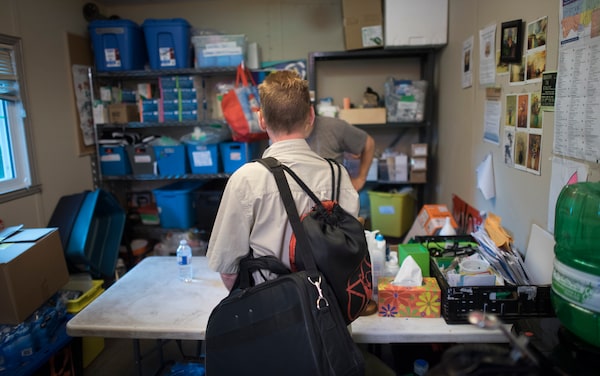
A visitor to the the Toronto Overdose Prevention Site, set up in a trailer in a corner of Moss Park in downtown Toronto, on June 18, 2018.Fred Lum/The Globe and Mail
The Ontario government is overhauling its system for overdose prevention by forcing existing centres to reapply and meet a new set of requirements while moving to strictly limit the number of new sites that are allowed to open. Addiction experts are warning the cap could have dire consequences in communities facing an opioid crisis.
Ontario Health Minister Christine Elliott announced on Monday that after a three-month review, the provincial government will keep funding the sites but rename them “consumption and treatment services.”
“Government cannot turn a blind eye to the crisis that is unfolding in front of us,” she said.
But the province will cap the number of sites at 21, three more than the 18 that are currently in operation. Ms. Elliott said the number meets the needs of communities across the province, but stressed they are part of an overall strategy to combat drug abuse.
“This is only one piece of a much bigger picture that we’re talking about, including more detox beds, more mental-health and addictions services; housing is another issue. There are many, many elements of this,” she said.
Addiction experts say the cap doesn’t make sense considering the extent of the opioid crisis in Canada and the fact overdose deaths are on the rise. There were 1,127 opioid-related deaths in Ontario last year, up from 726 in 2016.
“This crisis is not abating. It’s getting worse month over month,” said Sarah Ovens, an organizer with the Toronto Overdose Prevention Society. “We need more of these services.”
Matt Turner, harm-reduction co-ordinator with the Gilbert Centre in Barrie, said they applied for an overdose-prevention site in March and doesn’t know if it will ever move forward.
“Our community is one of the top three in the province for overdoses,” he said, adding that there was another death last week. “We are quite concerned the crisis is escalating.”
Existing overdose-prevention sites will have to reapply under the new consumption-and-treatment-services model, which won’t allow for pop-ups or tents. The sites will also have to consult with communities and report regularly about the number of clients and services accessed. They will be subject to an audit and inspection on a random basis and in response to complaints, with annual reviews.
Ms. Elliott said the government will work with the sites to help ensure there is “no disruption to effective services currently under way.”
Many addiction experts said they support the decision to keep the sites open, but expressed concern the province will only allow a total of 21 overdose-prevention centres. There are currently 18 sites in operation, according to Ms. Elliott, and three more are ready to start providing services in Thunder Bay, St. Catharines and Toronto. They were set to open in the summer, but the provincial government put it on hold while it conducted a review of the overdose-prevention model.
The government said the approved sites would begin to transition to the new model beginning in January, 2019, with all locations expected to be in place by April.
Adam Chalcraft, harm-reduction-program supervisor at the Peel HIV/AIDS Network, said the centre submitted an application to have an overdose-prevention site in the community last year, but now it’s unclear whether that will ever go forward. He questioned why the province has moved to strictly limit the number of sites that can operate given the seriousness of the overdose problem in many communities.
“No one seems quite certain where that number came from,” he said. "I think obviously these types of services need to be made available based on need."
Brian Lester, executive director of Regional HIV/AIDS Connection in London, Ont., which runs an overdose-prevention site, said he doesn’t know what the future holds. The centre’s contract is set to expire next week and he’s not sure if it will be extended until the new provincial model starts running in January.
Until now, there have been two types of harm-reduction sites in Ontario: supervised consumption sites, which are approved by Health Canada after a lengthy, rigorous application; and overdose-prevention sites, which were designed to be temporary centres to address the opioid crisis. Health Canada granted the Ontario government an exemption last year that allowed the province to approve the temporary overdose-prevention sites.
Now, addiction experts say it’s unclear what role the federal government will play in harm reduction and overdose prevention in Ontario. While it’s possible for Health Canada to allow more sites to open, it’s unlikely to happen because Ontario provides the funding to these centres, said Sarah Ovens, an organizer with the Toronto Overdose Prevention Society.
Thierry Bélair, press secretary to federal Health Minister Ginette Petitpas Taylor, said in an e-mail the office is “reviewing the Ontario government’s decision regarding the province’s sites.”
 Carly Weeks
Carly Weeks Laura Stone
Laura Stone